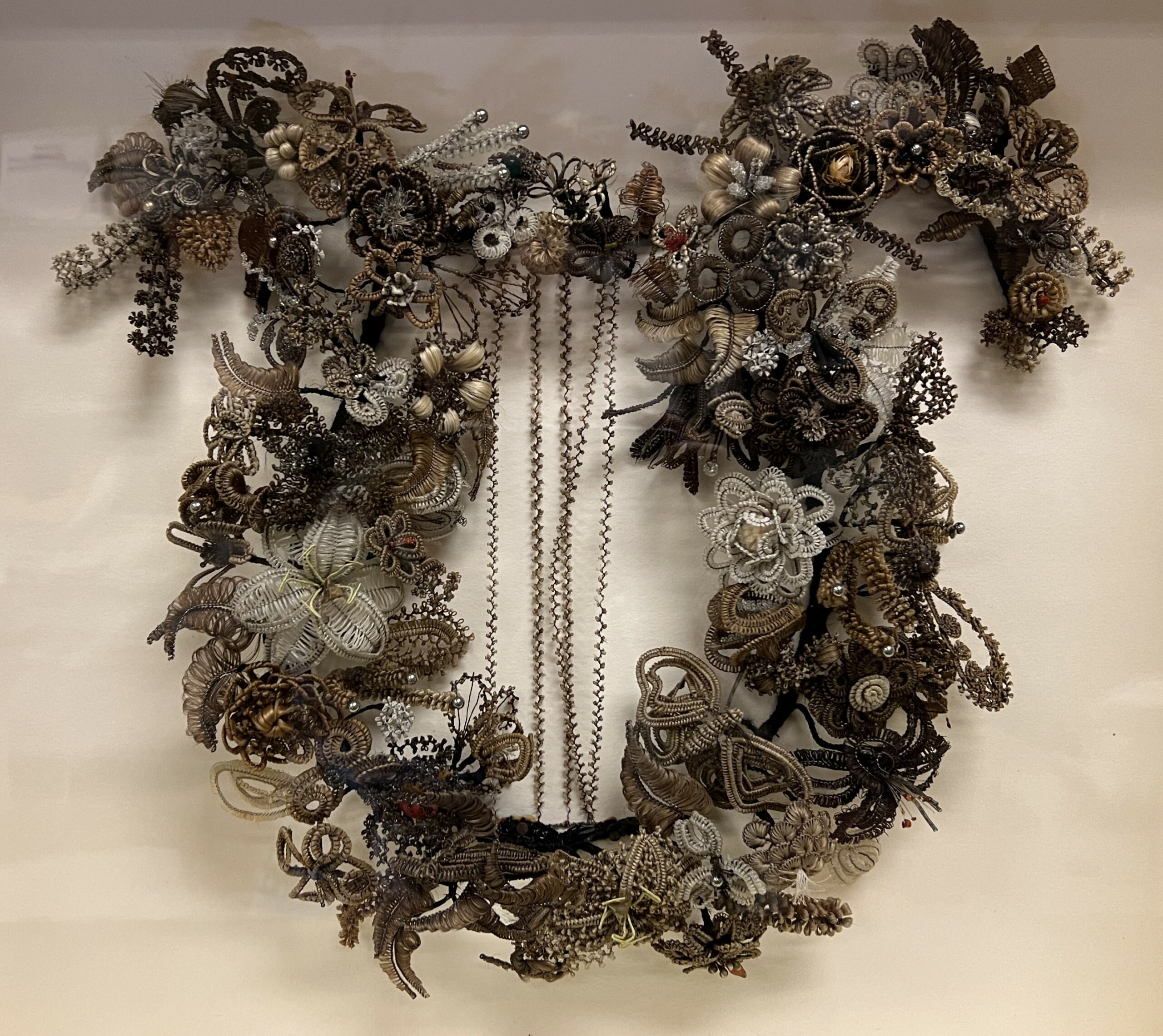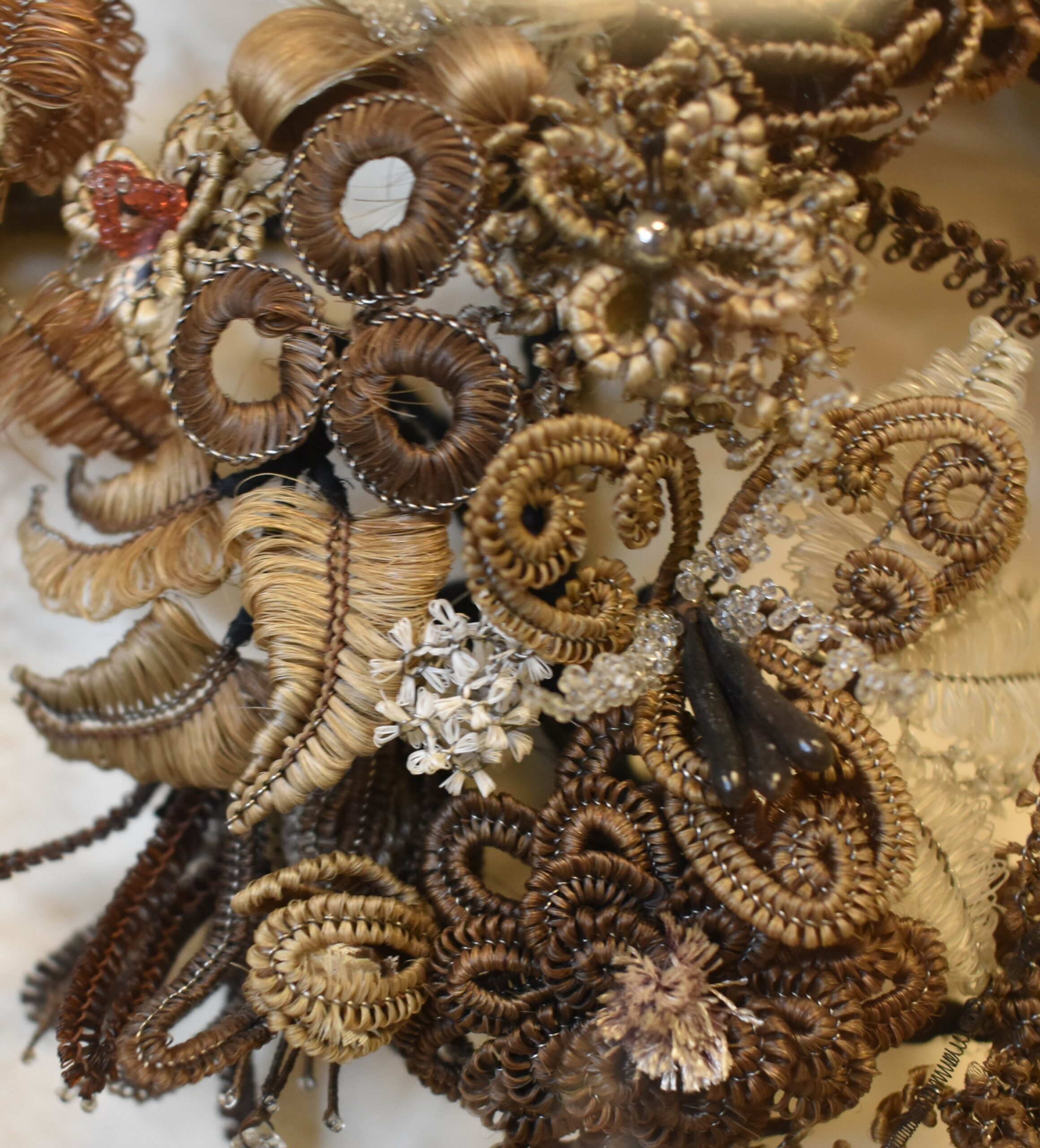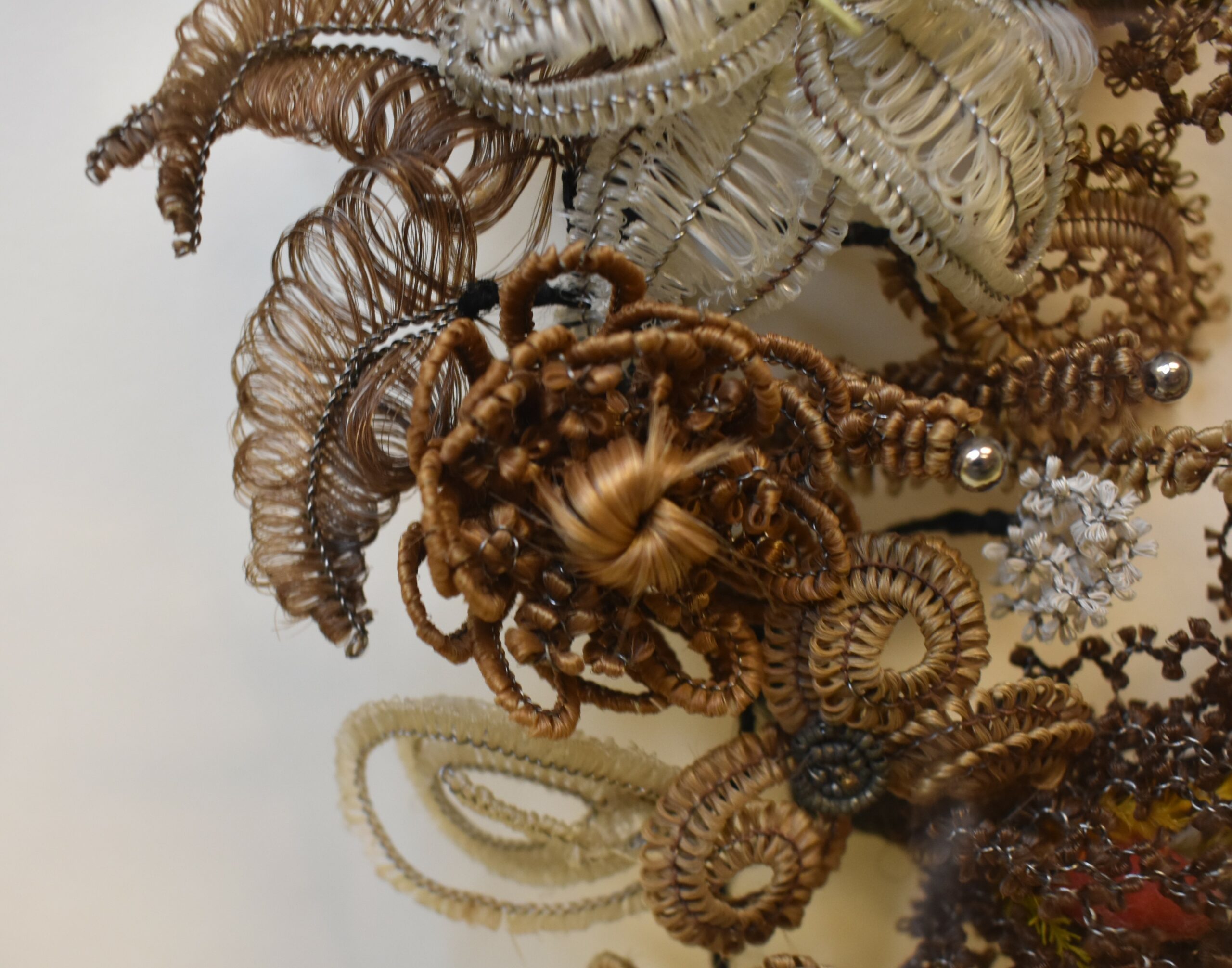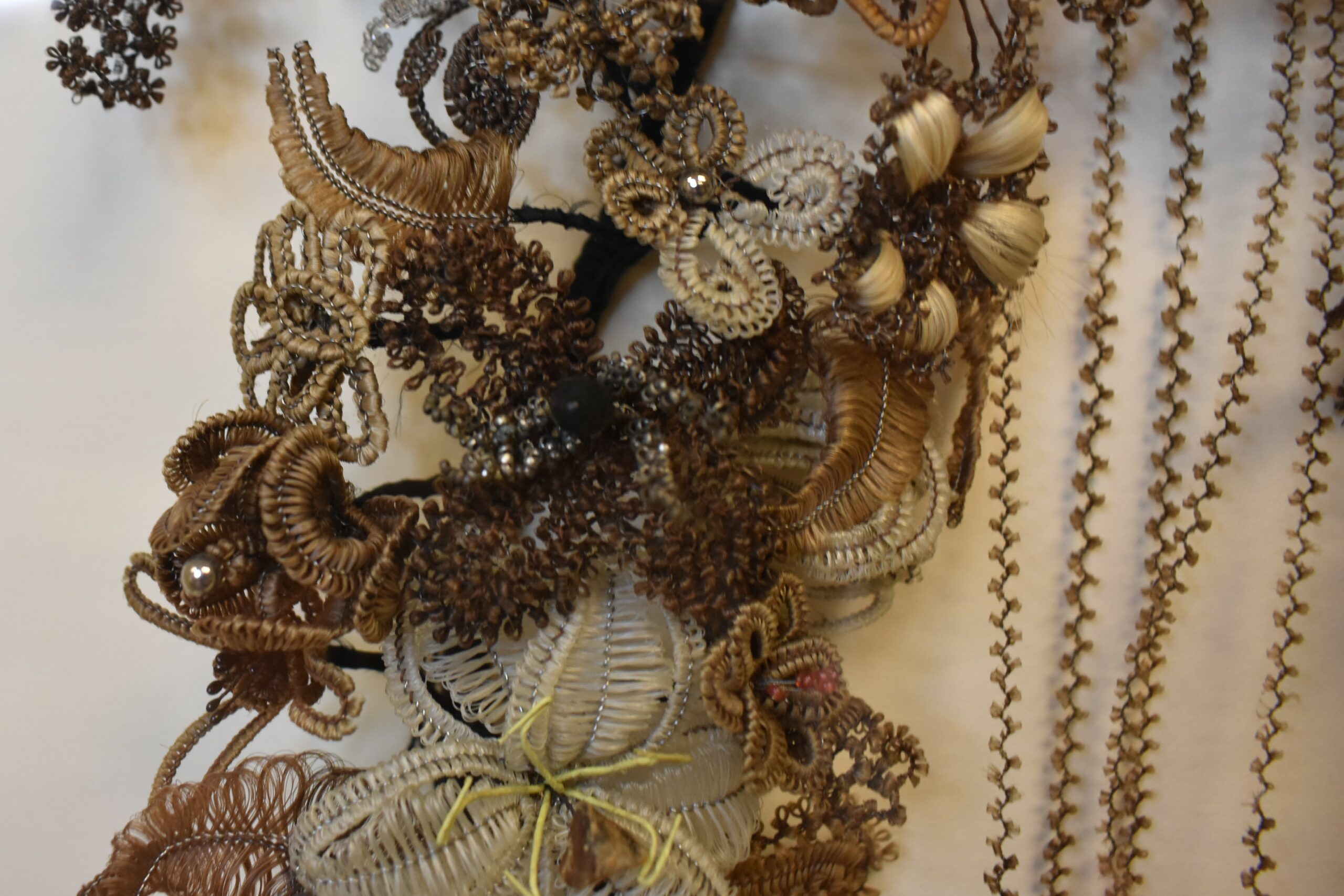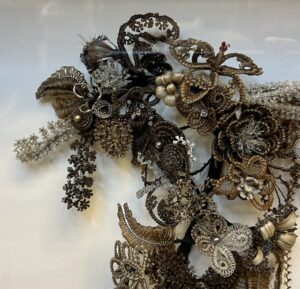
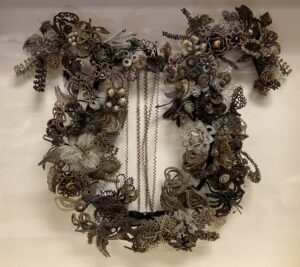
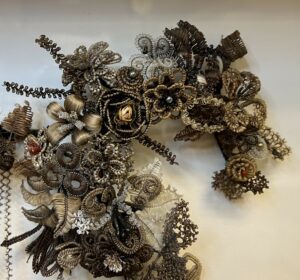
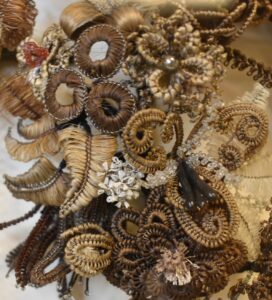
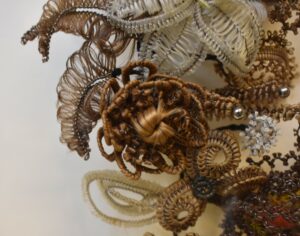
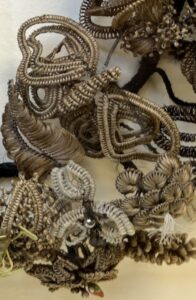
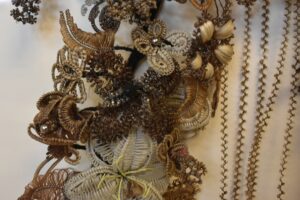
Mourning Sampler, ca. 1870. 79.90.1
This wreath made of human hair is framed in a deep wooden shadow box with carved leaves on the corners and a gold inner frame. It is shaped like a lyre. There are many shades of hair from multiple people including white, gray, pale blonde, reddish blond, light brown, and very dark brown. The hair is held in shape by wire that forms many kinds of flowers, leaves and floral shapes, butterflies, and decorative shapes. There are also glass and metal beads of various sizes.
Frances Brown was born in 1842 in Mendon, New York, to Elisha Brown and Mary Durfee. She grew up in a farming family and married late in life at the age of forty-eight. She married Justus Warner Gurney, also a farmer and son of Rush Gurney and Cordelia Joy, in 1890 in Palmyra, New York. She would continue to live in Palmyra for the rest of her life. This was the second marriage for Justus, his first wife and only child having passed away a few years prior. They did not have any biological children together, but they had an adopted daughter, Garnett, who would have been around ten when they adopted her.
The museum estimates this hair wreath to have been created around 1870. Frances collected the hair to make the wreath from her friends and family. There are many different shades of hair from several people, and it would have held a place of pride in her house and served as a remembrance of her loved ones. Justus passed away in 1920, and Frances passed away in 1935 at the age of 92. She enjoyed reminiscing with the townsfolk and spoke of living on her grandfather’s farm and seeing the New York Central Railroad being built. She also spoke of the events leading up to the Civil War and spoke of putting together packages of supplies and sending them to the volunteers from her area. She also helped during World War I by knitting sweaters, mittens, and socks. She was the second oldest member of the community when she passed away.
At first glance a hair wreath, to some, can look like a messy, drab, nest of some sort. However, upon closer inspection one finds a miniature world of flower arrangements, butterflies, and even birds all carefully constructed with human hair. They are absolutely stunning in their intricacy. “Every meticulous knot in a strand or delicate petal of a flower formed with hair and wire reflects an intimate connection between the artist and the absent subject that acted as both portrait and talisman of a relationship.”1 With wire to give it form a multitude of designs could be made. Most often these formed a type of opened ended wreath, shaped much like a horseshoe, with the open end placed at the top. There has been speculation that this might signify good luck, as that is the proper way to hang a horseshoe, or that it could mean it has been left open to signify the soul’s ascension to heaven. Another theory is that the circular shape represents the circle of life, made with the hair of the young and the old. The Gurney wreath is slightly unusual in that although it follows this horseshoe shape it also has a closed top and was cleverly made to look like a lyre, a musical stringed instrument.
Although the idea of using human hair may seem strange to us, hair has long been seen as a token of esteem. “Often people would cut a lock of their hair, place it in a piece of jewelry, and give it to a loved one as a keepsake. Women would give their sweetheart a lock of hair if he was going off to war or was going to be away for a long period. Parents would cut locks of hair from a child who has passed as a way of remembering them.”2 Sometimes elaborate wreaths would be made as a way to chart the history of a family. One hair wreath was made up of the hair of fifty-three members of a family, the most important people in the artist’s life including stands of hair from her favorite horse. Most likely made with hair from family both living and dead, she placed on the back of the piece a diagram listing each family member’s name and where their hair is in the design.3 It was the ultimate symbol or love and remembrance and made with a material that is extremely resilient.
Although the Gurney wreath is purportedly made with the hair of (presumably) living friends and family this is not always the case. In a time where mortality rates, especially in infants and children, were so high, and before photography was readily available, a lock of hair was a way to keep someone close to you, a symbol of love and grief. Victorians were notoriously sentimental and had elaborate mourning customs. Wreaths were sometimes made with a recently passed loved one’s hair and it was placed in the center of the shadow box. As another person passed this was moved aside and the new one was placed in the center, and this went on until the wreath was complete.
Wreaths were not the only objects made with hair. Many objects in addition to wreaths and wall art were made such as three-dimensional floral forms under glass domes, boxes with glass enclosures, and numerous types of jewelry from brooches and bracelets to rings and watch fobs. This was a way to keep a loved one especially close to you as it could be worn on your body. The brooches are especially beautiful. They may form designs such as bouquets, sheaves of wheat, tiny braids, or weeping willow tress which signify death and sorrow. Sometimes even the cuffs of bracelets were made of hair, or the hair of the living would be woven into that of the dead. The GCV&M has several pieces of hair jewelry with an especially lovely one formed of tiny woven locks of hair. The village also has another hair wreath that can be seen in the famous Octagon House, also called Hyde House, and was made by relatives of the original owners of the house.
Hair art went out of fashion in the late 19th and early 20th century. Most likely as photography was much more readily available and served as a more visual remembrance of the details and features of a person. However, some artists continue to use hair as part of their art today. And much like our ancestors many people save a lock of their child’s hair when they get their first haircut. Perhaps we are not so different after all.4
- Allison Meier, “The Curious Victorian Tradition of Making Art from Human Hair,” Artsy, February 13, 2018, https://www.artsy.net/article/artsy-editorial-chicago-gallerist-easy-otabor-setting-sights-tokyo. ↩︎
- “The Art of Hair Wreaths,” Hardin County Historical Museums, Inc., November 10, 2021, https://www.hardinmuseums.org/post/the-art-of-hair-wreaths. ↩︎
- John Whitenight, “Trim and Ends,” The Magazine Antiques, March 6, 2018, https://www.themagazineantiques.com/article/trim-and-ends/. ↩︎
- For an instruction booklet written in 1867 and filled with patterns and designs to make hair jewelry see: https://archive.org/details/selfinstructori00campgoog/page/n12/mode/2up?view=theater. ↩︎

